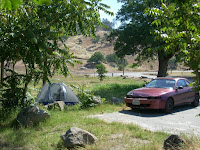Stansport Backpacking Tent: Reflection and Review
By Armando Ortiz
 |
| Spring 2009, first camping trip with tent. |
I bought my first camping tent back in
2009 at a surplus store in Moss Landing, California. It was in the back of a
huge military storage container tucked in between other larger items, ammunition
boxes and wool blankets, where I found the portable tent. It was blue and gray Stansport
Denali II two person backpacking tent that I bought that day and since then this
living space has given comfort and protected me from different weather conditions
that have arisen in my travels. I’ve used the tent mostly to camp in California, along the
coast, inside the redwood forest, up in the mountains, and have also used it at
local music festivals.
 |
| Valley of the Rouge State Park |
The tent has held up well, keeping
its integrity despite a nick on the floor from grounds that have been covered in rocks, sticks and pine-cones. Nonetheless a good tarp or footprint has provided an extra layer
of protection, but as any camper I’ve made sure to clear up areas I choose to
hunker down on. The two aluminum poles continue to work fine along with the
zippered doors. You can set up the tent in a couple of minutes and move it to a
better spot if need be, before the stakes are hammered into the
ground to give it better stability. Because it is so light, and can be moved
around after the tent is pitched, as you break up camp it’s easy remove sand or
debris that makes its way inside by simply picking it up and giving it a couple of
good shakes.
I also discovered how versatile this
tent can be, with the rainfly helping to keep my shoes and backpack water and
dust free, while keeping things separate from inside and yet easily accessible, at arm’s length.
The vestibule also has allowed me to redirect air flow into the tent more
freely by letting me roll up different parts of the rainfly. The doors of the
domed tent can also be rolled up, allowing for more air flow from any direction
and yet a high level of privacy is maintained. It conveniently lets me roll my
tent doors so that the mesh doors protect me from bugs, giving me a chance to nap in
the day time.
 |
| Roasting corn. |
During my camping trip to Southern Oregon and Northern California this past summer my seven year old tent
withstood late spring rains at Valley of the Rouge State Park, kept me warm and
cozy at Harris Beach State Park and MacKerricher State Park where the cold coastal winds bring in the summer fog to the camping areas and the temperature drops to the chilly upper 40s. It protected me from the clouds of mosquitoes that
hovered over Standish-Hickey State Park and Hendy Woods State Park, turning a nuisance into an opportunity to relax and read a book while resting inside comfortably. Because it is backpacking
tent, it is very light weight and is kept in the trunk of my car. Its portability makes it ready for any well planned trip or one that has been made at the spur of the
moment. It continues to do its job, to protect me from the elements, and is
still enduring the test of time. I continue to look forward to returning to the
wilderness or of simply finding an excuse to go car camping. I know that this
Stansport tent will hold up and continue to give me shelter.
 |
| Humboldt Redwoods State Park |






